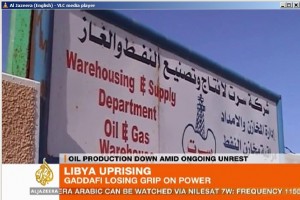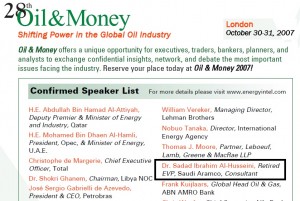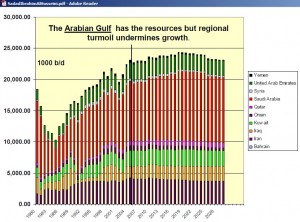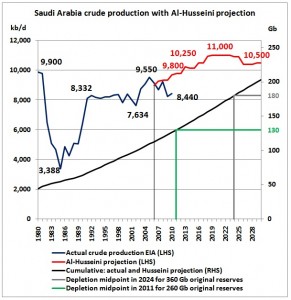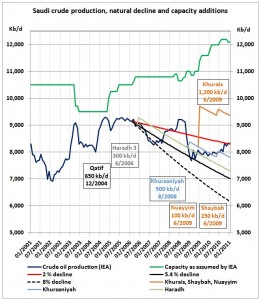Can Saudi Arabia step in to replace oil production lost in Libya? When the Guardian published Wiki leaks cables from the US embassy in Riyadh in early February 2011 it sparked a short debate on Saudi oil reserves but the world’s focus was on events in Egypt and the issue was quickly forgotten. But the reason for the cable was a presentation of ex-Saudi Aramco chief Sadad-al-Husseini at an Oil & Money conference by Energy Intelligence in London in October 2007 which showed future production profiles with a Saudi production of only 9.8 mb/d in 2011. Many analysts now assume Saudi Arabia can pump 12 mb/d which would be very important to offset production cuts in Libya which seem to be between 50% and 75%. Other oil producing countries are also in turmoil.
The situation changes on a daily basis with warnings issued by the International Energy Agency (more – www.iea.org/…)
2/3/2011
“….it would appear that between 850 Kb/d to 1 mb/d out of a total of 1.6 mb/d of Libyan oil production is currently shut in” (more – www.iea.org/…)
(more – http://english.aljazeera.net/…)
(1) Introduction
(a) Analyst Steve Levine from Oil & Glory asks: If the world calls, will Saudi be there? 22/2/2011
http://oilandglory.foreignpolicy.com/posts/2011/02/22/if_the_world_calls_will_saudi_be_there
(b) What will happen with oil contracts? Libyan rebels say control oil fields, honor oil deals 25/2/2011
“If oil contracts were unfair or based on corruption, however, the interim leadership of Libya’s second city Benghazi said they reserved the right to renegotiate them.” (more – http://www.reuters.com/…)
(c) While Saudi Arabia announces:
Saudi raises oil output as Libyan exports disrupted 25/2/2011
“We have started producing over 9 million barrels per day. We have a lot of production capacity”, the industry source familiar with Saudi production told Reuters. That would be up more than 700,000 bpd from January. (more – http://www.reuters.com/…)
(2) WikiLeaks cable on Saudi Arabian crude oil production
WikiLeaks cables: Saudi Arabia cannot pump enough oil to keep a lid on prices 8/2/2011
According to the cables, which date between 2007-09, Husseini said Saudi Arabia might reach an output of 12m barrels a day in 10 years but before then – possibly as early as 2012 – global oil production would have hit its highest point. This crunch point is known as “peak oil“.
http://www.guardian.co.uk/business/2011/feb/08/saudi-oil-reserves-overstated-wikileaks?intcmp=239
The original cable was also published by the Guardian and can be found here:
http://www.guardian.co.uk/business/2011/feb/08/oil-saudiarabia?intcmp=239
The meeting Sadad-al-Husseini had in the US embassy in Riyadh in November 2007 was about his slide show, 3 weeks earlier, at an Oil & Money conference in London on 30th October, at Energy Intelligence.
The above is an extract from the original speaker’s list. The quoted link to the 2007 conference no longer contains any details to the presentations shown but this a slide from Husseini’s presentation showing a crude oil production profile of OPEC countries, past and future:
Note “regional turmoil undermines growth” in the title.
(3) Husseini’s maximum production for Saudi Arabia
We extract Saudi Arabia’s production profile from the above graph, add it to the actual production curve (EIA crude oil data) and get annual production in kb/d (LHS) and cumulative production in Gb (RHS). (Please note there can be inaccuracies of + – 100 kb/d as production figures have been taken from the above graph and not from a data table). This is the result:
What this graph shows (EIA data):
- Actual Saudi crude oil production up to 2010 (dark blue curve)
- Al-Husseini’s projection starting in 2006, peaking at the end of this decade (red curve) at 11 mb/d, 1 mb/d below the claimed capacity
- Accumulated production using Husseini’s projection (black curve)
- The depletion midpoint in 2024 for an original Saudi reserve of 360 Gb
- The depletion midpoint in 2011 for an original Saudi reserve of 260 Gb
It can be clearly seen that since Husseini’s projection was done in 2007, Saudi production did not follow the red curve. Yes, there was a recession with less demand but OPEC as a whole was able to increase production. So what’s going on in Saudi Arabia? Why didn’t they pump?
From The IEA WEO 2005, published in November 2005, we knew
“In the last two years, there has been growing speculation about the ability of Saudi Aramco to sustain output from its mature fields because of technical difficulties, notably falling pressures and increasing water cuts. For example, production from the offshore Safaniyah field has been partially curtailed due to water encroachment. The company estimates that the natural decline rate – the rate at which production would decline in the absence of any maintenance or new drilling – at existing fields is around 6%. If this is the case, about 600 kb/d of capacity has to be added each year just to maintain overall capacity” (page 511). (more – www.worldenergyoutlook.org/…)
In this April 2006 article on Platts http://www.platts.com/ we get more details:
Saudi Aramco’s mature crude oil fields are expected to decline at a gross average rate of 8%/year without additional maintenance and drilling, a Saudi Aramco spokesman said Tuesday
But Saudi Aramco has taken a number of measures to offset a decline in output from the country’s aging oil fields, the spokesman added.
“A variety of remedial activities are always being taken in oil fields influencing their effective decline rates” the spokesman said. “The drilling of additional development wells in the producing fields is Saudi Aramco’s standard practice to offset normal declines of older wells”
This is particularly important when oil fields are progressively depleted under a well thought out strategy of maximising the sweep and displacement efficiencies, leading to high ultimate oil recovery, the spokesman said
“This maintain potential drilling in mature fields combined with multitude of remedial actions and the development of new fields, with long plateau lives, lowers the composite decline rate of producing fields to around 2%” the spokesman said.
And since this article is no longer available on the Platts web site, this is a partial screen dump
The rest of the article is about projects needed for that remedial work, scheduled to come on-stream in 2007. It’s available here: (more – www.greenenergyinvestors.com/…)
So let’s put this into a graph, using data from the IEA (we switch to IEA data because they estimate Saudi capacities in their Monthly Oil Market Reports here: http://omrpublic.iea.org/ )
(5) Short history of capacity calculations by the IEA
The dark blue line is the actual crude oil production, the green line the capacity as assumed by the IEA. In 2001 and 2002 the IEA just accepted the official capacity of 10.5 mb/d given by Saudi Aramco. Then, in January – May 2003, Saudi Arabia’s capacity was tested before, during and after the Iraq war. The maximum production was in April 2003 at 9 mb/d and the IEA lowered the capacity to 9.7 mb/d.
In the IEA oil market report 3/2003, we read: “OPEC spent much of February attempting to reassure the market that it could and would step into the breach in the event of an Iraqi supply disruption. However, OPEC statements that spare capacity remained around 3-4 mb/d appeared to be stretching reality, something that was borne out by relentlessly high prices”
Only as Qatif and Haradh3 came online in 2005/06 did the IEA see capacity going back up again to previous levels of 10.5 mb/d
By that time Saudi Aramco had embarked on a massive program to revive old fields mothballed earlier. The 1st field to come on-stream, planned for end 2007, was Khursaniyah. But works were delayed (technically challenging) and the production ramp up starting in August 2008 came too late for an additional demand for the Olympic games of 800 kb/d in mid 2008. Saudi capacity was tested but did not exceed 2005 levels after Qatif came on-stream. Therefore, lack of Saudi capacity contributed to the $147 a barrel oil shock. Yes, it was the “coming Saudi oil shock and the world economy” predicted by Matthew Simmons in his 2005 book “Twilight in the Desert”
IEA Monthly Oil Market report 9/2008
Saudi Arabia reportedly saw initial volumes produced from the AFK (Khursaniyah) project after long delays associated with gas processing facilities. Production of crude is seen building to an initial 250 kb/d in the next few months and 500 kb/d in early 2009
In the same reporting month the collapse of Lehman Brothers changed the whole oil demand situation and the new fields were actually not needed.
IEA Monthly Oil Market Report 6/2009
“Details about the start‐up of production totalling a staggering 1.55 mb/d this year have been equally vague. Obviously, the lack of demand for extra crude has forced Saudi Aramco to revise its production strategy but whether the company brings the new streams on line in a staggered fashion or opts to start operations at the new fields and then shut‐in production at older fields for maintenance work or more extensive rehabilitation is unclear.”
So here the IEA lost track of what was going on in Saudi Arabia. They had no other choice than to add the new fields to the earlier capacity of 10.8 mb/d. But knowing about depletion, instead of adding 2.05 mb/d (Khursaniya, Shaybah, Nuayyim, Khurais) they just increased capacity by 1.4 mb/d, cautiously and step by step, to arrive at a “nameplate capacity” of 12.1 mb/d by end 2010, very close to Saudi Aramco’s official figure.
Obviously, the IEA did not consider the July 2008 spike as an indication of limited capacity as they had done during the Iraq war surge.
(6) Alternative capacity guestimate
So back to the 2006 Platts article on oil decline. Maybe that will help us to do a guestimate. From the beginning of 2006, we draw 2% and 8% decline lines. Incidentally, the 2% line hits current production by end 2010. We also see that actual production in 2006/07 followed the natural decline rate (very scary), leaving just 300 kb/d from Haradh 3 as spare. If we had started the decline lines earlier so that there was no spare capacity in 2006 they would come out lower by that volume in 2010. So our calculation could be too high by 300 kb/d
In 2006/07 Saudi Arabia lost production share to Russia, so the decline was not caused by lack of demand: http://www.crudeoilpeak.com/?p=1800
The Platts article mentions infill drilling and other improvements. We have:
(1) production end year n
(2) + annual incremental production from infill drilling, work-overs and other improvements in existing fields
(3) + production from new fields coming on stream in year n+1
________________________
(4) = production end year n+1
We know which new fields have came online but can we get a handle on (2)? There are no public data available. But we can indirectly calculate this by looking at this 3 year period:
January 2006 production around 9,200 kb/d
January 2009 production around 8,000 kb/d
Difference…………………….. 1,200 kb/d decline
During that period, only Haradh 3 came on-stream with 300 kb/d so without this new field the decline would have been 1,500 kb/d or 500 kb/d pa, around 5.4 % pa. In other words, the natural decline rate of 8% was lifted up to 5.4 % by improvements in existing fields.
So we draw a 5.4% line in the above graph and add the new fields on top of that line (grey, light blue and brown lines). The capacity in December 2010 comes out as 9,400 kb/d, just 1.1 mb/d above the 8,330 kb/d in December 2010. Please note that IEA crude oil data in 2010 were by 400 kb/d lower than EIA data used in Husseini’s graph so our guestimate comes very close.
Let’s go back to Husseini’s 9,800 kb/d for 2011. His assumption was an original reserve of 360 Gb implying he accepts Saudi Aramco’s official remaining reserves of 260 Gb. However, his slide show contains a graph about OPEC’s overstated reserves, around 300 Gb, part of which would be from Saudi Arabia. If, for example, Saudi Arabia’s official remaining reserves were actually original reserves, the depletion midpoint would be in 2011 instead of in 2024 and production would therefore be lower.
If we had started with our decline lines in 2005 so that after Haradh 3 no spare capacity had been available at all, our estimate would have been 9,400 kb/d – 300 kb/d = 9,100 kb/d (IEA data). Adding 400 kb/d to get to EIA data that would be 9,500 kb/d, also lower.
Conclusion: Present Saudi crude oil production capacities at 12 mb/d are most likely too high. They can be between 9,800 kb/d (Sadad-al-Husseini) to 9,500 kb/d (EIA data) as estimated above, suggesting a spare capacity of 1 mb/d to 1.5 mb/d above Dec 2010 levels. As historic examples show (Iraq war, Olympic Games in China) Saudi Arabia can deliver an additional surge production for a couple of months. However, the surge capacity has declined from 1 mbd/ in 2003 to 500 kb/d in 2008. But before we speculate on what the surge capacity is now let us first wait for the promised 9,000 kb/d. The above estimates demonstrate how tricky things can be and we therefore have to expect surprises.
